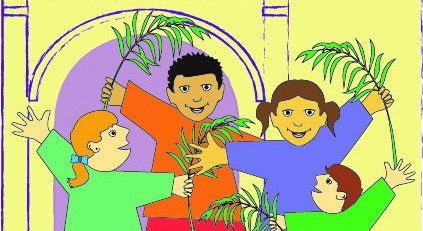Engaging young children in Easter services: resource and tips
Features
“In this Easter liturgy, the children take part in the key final events of Jesus’ life, from Palm Sunday to the Resurrection. They wave palms, taste the bread and wine (grape juice), run away from the soldiers, nail dowels into a cross, are buried (under sheets) and noisily celebrate the resurrection,” says The Rev’d Canon Dr Marian Free, while providing a helpful story and liturgical resource for parishes to download and tips for creating an Easter liturgy

During the course of my ministry, I have yet to experience the privilege of serving a parish with a strong children’s ministry or where there have been young families who worship on a regular basis. At the same time in all the places in which I have served, there have been a number of families who have been connected to the church through baptisms and other key events. I have, therefore, been challenged to consider how best to engage these families in the life of the church, while recognising that it is unlikely that they will develop the habit of regular Sunday attendance.
Advertisement
Christmas is generally easy. It is one time of year that many families, who do not attend church regularly, will make an effort to come along to one of the Christmas services and I inherited a form of liturgy in which all the children can be involved. It is absolutely chaotic, but has become the most popular of the Christmas services.
Easter has its own challenges. It often falls during school holidays and even when it does not, the festival has not caught the popular imagination in the same way as Christmas. So, I was challenged to create a liturgy that might fill this gap. It seemed to me that families whose children had recently been baptised might be most open to trying something new. This meant developing something that would engage children between the broad age range of two and 10. I could be certain that such young children would not be able to sit still and/or pay attention for very long.
The story of Easter begins on Palm Sunday and includes the difficult, but essential, retelling of the crucifixion. We all know how long it takes to read the gospel on Palm Sunday and Good Friday. I wanted to avoid lengthy dissertations at all costs. I was also aware that children – like adults – learn best from experience.
This meant I wanted to write something that was engaging, interactive, short and comprehensive. I no longer remember how I came up with the idea, but I remembered a well-loved children’s rhyme that was adapted in the popular contemporary book We’re Going on a Bear Hunt. It included all the important elements – it was engaging and had a rhyming response (which would help the children take part even if they couldn’t read) and the story moved along in such a way as to retain the children’s attention.
Advertisement
What emerged was Easter Is, which I published in 2007. In this Easter liturgy, the children take part in the key final events of Jesus’ life, from Palm Sunday to the Resurrection. They wave palms, taste the bread and wine (grape juice), run away from the soldiers, nail dowels into a cross, are buried (under sheets) and noisily celebrate the resurrection. The leader tells the story and the children follow, repeating the rhyme. It is all over in 30 minutes and the children are only seated for about 10 of those minutes.
In the years since I wrote Easter Is, I have used the liturgy annually. It has proved so popular that one year a child cried because she had a conflicting engagement and couldn’t attend!
Here are my ‘five top tips’ for creating a children’s liturgy:
- Plan to involve the children in a hands-on way as much as possible.
- Don’t expect them to sit still.
- Keep the input (and the service) short and brief.
- If possible, use a rhyming (or other) response so that you don’t need books and so children of varying ages and literacy stages can join in.
- Engage the parents so that the children understand that faith/worship is for everyone.
Editor’s note: Download the specially developed liturgy, Easter Is, for your forthcoming Easter services (please acknowledge the author when using this resource in services) or purchase a hard copy booklet (with full illustrations by Dr Jennifer Close) by emailing The Rev’d Canon Marian Free at marian.staugust@bigpond.com





